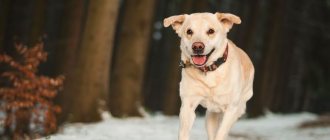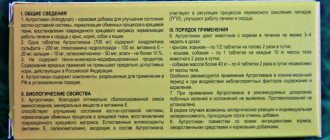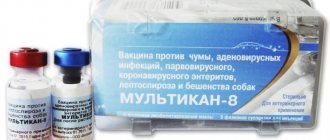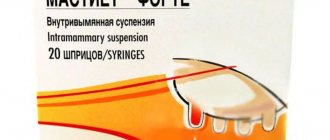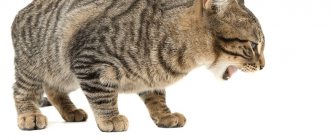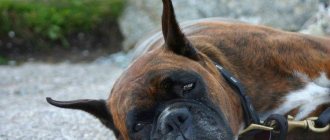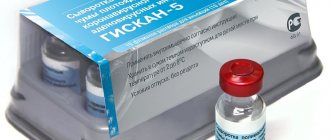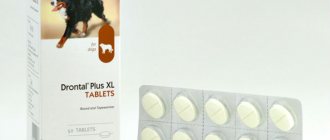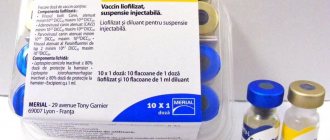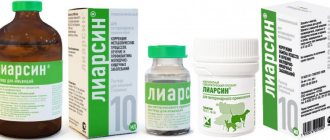In the article I will talk about the vaccine for dogs Multikan 6. I will give the composition of the vaccine and describe the mechanism of action. I will list the indications for the use of the vaccine. I'll tell you how to use it correctly and how to calculate the dosage. I will give similar vaccines and indicate the cost of Multican 6.
COMPOSITION AND FORM OF RELEASE MULTIKAN-6
According to the instructions for use, the vaccine drug Multikan 6
are made from attenuated strains of canine distemper virus, canine adenovirus type 2, parvovirus and canine coronavirus, inactivated strains of Leptospira serogroups Canicola and Icterohemorrhagia. The Multikan 6 vaccine consists of two components:
- lyophilized, against canine distemper, adenoviral infections, parvovirus and coronavirus enteritis of dogs liquid, against leptospirosis of dogs
- The lyophilized and liquid components of the vaccine are produced in volumes of 1 and 2 ml, respectively, in bottles or ampoules with a capacity of 3-10 ml. The vial (ampoule) contains one dose of each vaccine component. The liquid component is a lyophilized solvent.
- The lyophilized component Multikan 6 is a dry, homogeneous, finely porous mass of yellow-pink color. The liquid component is a colorless liquid with a gray-white precipitate that breaks up when shaken into a homogeneous suspension.
Mechanism of action and indications for use
This product helps to develop strong immunity against viral diseases in dogs and small puppies. It forms 2-3 weeks after administration of the drug and persists for 6-8 months in young animals, and for 1-1.5 years in adult animals.
Multikan 6 does not have medicinal properties, so it is used only for the prevention of the following diseases:
DOSES AND METHOD OF APPLICATION MULTIKAN 6
According to the instructions for veterinary use, clinically healthy puppies and adult dogs are subject to active vaccination. Before use, the lyophilized vaccine is dissolved in a bottle with a liquid component and shaken until a homogeneous suspension is obtained.
- Adult dogs are vaccinated with Multikan 6 once a year.
- The vaccine is administered intramuscularly in the thigh area in a volume of 2 ml immediately after dissolution. Dogs of small and decorative breeds are vaccinated in a volume of 1 ml. Syringes and needles are sterilized by boiling for 10 minutes before use. A separate needle is used for each animal.
- Puppies are given the Multikan 6 vaccine at 8-10 weeks of age
and again after 21-28 days. Revaccination of puppies is carried out at the age of 10-12 months.
Instructions for use of the vaccine
Before vaccination, you must make sure that the animal is completely healthy.
7-10 days before the administration of the drug, the dog must be dewormed with tablets or suspension (Dironet, Prazitel, Kanikvantel, etc.).
Vaccination is carried out as follows:
Puppies of medium and large breeds, as well as adults whose weight exceeds 5 kg, are administered the entire dose of the drug (2-2.5 ml).
Small pets are administered only 1 ml of the prepared suspension.
The vaccine causes the formation of an immune response in dogs to plague
STORAGE CONDITIONS
In a dry, dark place at a temperature of 2 to 8 °C. Shelf life of Multikan is 6 - 18 months.
Published canine vaccination guidelines allow the clinician to implement protocols designed for individual patients that provide protective immunity at appropriate life stages.
However, the protocols used in practice usually require the owner to comply with the recommended ideal Multican 6 vaccination schedule.
This article discusses immunization options for dogs. Remember, however, that the recommendations outlined are largely based on expert opinion; Published scientific research on revaccination requirements is limited.
- Core vaccines except rabies: 3 doses from 6 to 16 weeks of age
- Rabies vaccine: single dose at least 12 weeks of age
Medicine for dogs: instructions
All properties of this immune defense product are indicated in the attached instructions for use.
Available in cardboard packages containing five doses. Each of them consists of two ampoules: one contains a “dry” component - a lyophilized yellowish substance, the other contains a suspension or liquid content (may have a pinkish tint or be colorless). When mixed, a ready-to-use vaccine is obtained; it must be used immediately.
Attention! The components of the vaccine are mixed immediately before administration to the animal; storage of the diluted solution (even under freezing conditions) is not allowed!
Form of the drug: bottles with lyophilisate (active ingredient) and liquid.
A bottle containing 1 ml of dry substance and a bottle with 2 ml of liquid are equal to one dose of medicine. Read. Nobivac vaccination for dogs: instructions for use, types of vaccines
The active substance is attenuated viral cultures.
Compound. Often on the packaging you can see the nomenclature: Multikan - 1, Multikan - 2, and then - 4, 7, 8. The numbers indicate the presence of weakened (attenuated) viruses in certain strains. The higher the number, the greater the number of them contained. The vaccine with the highest number - 8 - is distinguished by the fact that it contains, along with six components, an inactivated rabies virus.
The following are infectious diseases for which an immune response is produced as a result of the administration of the following types of drug:
- 1 – against plague;
- 2 – from parvovirus enteritis and adenovirus infection;
- 4 – protects against enteritis caused by coronavirus, parvovirus, as well as against plague and adenovirus;
- 6 – includes protection against the same diseases as 4, plus immunization against leptospirosis;
- 7 – contains the same components as 4 and vaccination against dermatophytosis;
- 8 – the vaccine contains components Multikan-6 and against rabies.
In practice, veterinarians most often use Multikan - 4 and 8.
Properties
The vaccine is administered to increase the dog's body's resistance to these specific infections. It consists mainly of live cultures (the exception is its component used against rabies in the Multikan - 8 variant: it contains “killed” viruses).
In this state, microorganisms are not able to reproduce, but when a vaccine is administered, the animal’s body perceives them as “foreign agents” and actively begins to produce antibodies in response. In other words, after 14 - 21 days, immunity is developed, providing protection for a year or more. In puppies, protection lasts a little less: this period is about 6 – 8 months.
Indications for use
The medicine is injected into puppies and adult dogs according to the vaccination schedule for immunity against a number of dangerous infections, including adenovirus infection, leptospirosis, distemper and others.
Note. Vaccination should be carried out under the supervision of specialists, preferably in veterinary clinics. A week after vaccination, it is recommended to show your pet to a veterinarian.
Directions for use and doses
Vaccinations are given subject to preliminary deworming two weeks in advance, as well as after flea treatment. Manipulations are carried out with sterility, otherwise complications may arise in the form of suppuration, abscesses, etc. Before vaccination, it is recommended to administer an antiallergic drug.
Read. Anthelmintic for dogs before vaccination: rules and recommendations
The liquid for preparing the solution should be heated to a temperature of 36 degrees. This is necessary for better absorption of the substance, as well as to avoid the appearance of post-injection “bumps”.
Dry and liquid components are mixed. To do this, the suspension is “taken away” with a syringe and injected into another bottle. The resulting suspension must be shaken vigorously for several seconds until it becomes homogeneous.
The injection is made into the inner thigh of the animal; the injection site can be pre-treated with medical alcohol.
Small decorative dogs and puppies are given 1 milliliter of vaccine, adults receive the drug in a volume of 2 ml. The remaining vaccine is disposed of.
Below is the graph.
- Vaccination: the first time - at the age of 8 to 10 weeks, the second - three weeks later.
- Revaccination: at one year (in some cases at 10 months), then annually in adult dogs.
- Attention! Drugs with broken or missing labeling, expired, or those that have changed their characteristic color and properties, stored in conditions that do not meet the standards, are strictly prohibited to use!
Contraindications and adverse reactions
There are no special contraindications to the use of the vaccine. An exception may be individual intolerance to its components, puppies are less than 8 months old. You should not prick sick or weakened dogs. Side effects include swelling and slight hyperemia at the site where the injection was given, a temporary loss of appetite, a slight increase in temperature, they disappear after 1 - 2 days without treatment.
Learn about essential drugs in animals
- Vaccination of puppies
- Vaccination of cats against rabies
- Vaccination of small animals
- Kitten vaccination
- Vaccination of dogs against rabies
- Why do kittens need to be vaccinated?
- Nobivac Triquet Trio
- Nobivac DHPPi for dogs
- Puppy's first vaccination
- Comprehensive vaccinations for cats
- Tick vaccination for dogs
- What vaccinations are given to dogs and why?
- Why is Ursofalk prescribed to cats?
- Instructions for using serenia for animals
- Ursofalk in dogs
- Marfloxin for veterinary medicine
- Instructions for the use of serenia in dogs
- Instructions for using serenia in cats
- Why is Heptor prescribed to a dog?
- Instructions for the use of lidocaine in dogs
- Heptor in cats
- Lidocaine for cats. Can cats use lidocaine?
- Heptral in dogs
- Can cats use marfloxin?
- Marfloxin for dogs (instructions for use)
- Heptral in cats (instructions for use, pharmacology
- Instructions for use of Dirofen for cats
- Instructions for using Vetom in cats
- Instructions: multifel for cats
- Use of fosprenil in cats
^Top
Side effects and contraindications
Side effects include only the formation of a small, slightly painful swelling at the site of needle insertion. This seal resolves within 1-2 days. Also, in rare cases, an individual allergic reaction may occur; in this case, the animal is given antihistamines.
Contraindications include the presence of clinical signs of one of the viral diseases in the dog: fever, depression, discharge from the eyes and nose, vomiting, diarrhea, etc. It is also prohibited to administer the vaccine to dogs in the last month before birth and another 30 days after it.
Personal prevention measures
- When working with the vaccine, you should follow the general rules of personal hygiene and safety precautions provided for when working with veterinary medicinal products.
- All persons participating in vaccination must wear special clothing (robe, trousers, hat, rubber gloves). Places of work must have a first aid kit.
- If the vaccine gets on the skin and/or mucous membranes, it is recommended to rinse them with plenty of tap water.
- In the event of a vaccine spill, fill the contaminated area of the floor with a 5% solution of chloramine or sodium hydroxide.
- If the drug is accidentally administered to a person, the injection site must be treated with a 70% solution of ethyl alcohol, contact a medical facility and inform the doctor about this.
Instructions and dosage
Before using this remedy, carefully study the basic rules of administration. Be sure to preheat the prepared composition to a temperature of 36 °C. Then shake the resulting liquid thoroughly to form a homogeneous suspension. Next, dissolve the lyophilized component in 1-2 mg of solution depending on the size and weight of the dog.
If a precipitate has formed that is difficult to remove, pipette the vaccine in the vial 3-5 times using a regular syringe until you obtain a homogeneous suspension. For injections, use only sterile materials.
As for dosage, follow the recommendations indicated in the instructions for the drug. If the dog is a small, decorative breed, such pets should be vaccinated in a dose of 1 ml. For adults, large breeds, the norm is twice as much, that is, 2 ml.
Description of the vaccine
Multikan is divided into several varieties - 4, 6, 8. The distinctive features of each type of product lie in their ability to prevent the occurrence of a different number of pathological processes.
Vaccine number 8 is considered one of the more popular ones, since with its help it is possible to prevent the development of most diseases in your four-legged friend.
The drug contains live viruses that contribute to the occurrence of pathologies dangerous to dogs.
There are very few pathogens in the product, and the animal does not become infected with them, but a stable immune system is formed.
In case of infection with a virus after vaccination, lymphocytes give an appropriate response to a familiar infection and prevent its further reproduction. It may be that the available antibodies are not enough to prevent the development of a possible disease.
Over time, the death and disappearance of the injected antibodies is noted. Their effect sometimes reaches up to 2-3 years, in some cases no more than three weeks.
The timing is influenced by indicators such as:
past illnesses;- age of the animal;
- bearing puppies and other physiological characteristics.
To prevent unwanted problems, veterinarians recommend strictly adhering to the established vaccination schedule.
Multikan is not a medicine. It is used not for treatment, but for the prevention of disease. Vaccination is carried out only for healthy animals.
Reviews about Multikan
- Victor, Rostov region.
I have been professionally breeding dogs for ten years, the last six of which I have given preference to Multikan. This happened because in the case of the imported drug, a deterioration in the well-being of animals began to be recorded. The veterinarian recommended Multikan. Excellent result. The biggest “sorrow” was when the puppy developed characteristic swelling and slight pain at the injection site; within a week they were gone without a trace. All dogs were active after the procedure; there were no cases of disease after vaccinations.
- Oksana, Moscow.
Read. Vaccinations for piglets from birth at home
I bought a Yorkshire Terrier. Fortunately, he had already been vaccinated for the first time, so he lived peacefully for a whole year, enjoying how this little “lump” was slowly growing. However, the time for revaccination has come. Of course, I was very worried, but I went to the vet on time. The specialist said that this was the first time I was injected with Multikan, so it is advisable not to change the drug.
In general, my Marquis tolerated the vaccination well, although he was a little “cranky” and whining until the end of the day. But the next day everything was forgotten, the pet was playful and cheerful.
- Denis, Voronezh.
For my 16th birthday, my parents gave me a cocker spaniel. My happiness knew no bounds, but along with joy came a lot of worries. The most important of them is to protect your little friend from diseases. The veterinarian prescribed Multikan: they say it is a good drug, does not cause allergies, and is well tolerated. I decided to support our manufacturer. And I don’t regret it! I’ve been vaccinating them for six years now - no allergies, the dog is healthy and full of energy.
Differences between drugs
The product is produced in several variations, and their composition is different. "Multican-6" protects the animal from plague, adenovirus infections, coronavirus and parvovirus enteritis, and leptospirosis. But the vaccine is not able to provide protection against rabies. A similar drug with the number “4” does not provide protection against rabies and leptospirosis. Unlike number six, Multikan-8 is able to ensure the safety of a pet even if it is bitten by another animal infected with rabies.
As you can see, depending on the number, the drug can suppress a greater or lesser number of infections and viruses. Immunity after introduction into the body of a four-legged friend is restored after two or three weeks (maximum). The rules of application are identical regardless of the chosen brand.
When to use
This vaccine should be given when the puppy is eight or nine weeks old. Reapply it after four weeks. Revaccination is carried out when the dog turns one year old.
It is worth considering that for an adult dog this procedure must be carried out annually. But if the purchased drug is out of date, be sure to destroy it - you cannot administer such a vaccine, otherwise the consequences may be irreversible.
In addition, please note that if there is damaged packaging or sediment in the liquid, it is strictly not recommended to use Multikan-6 - this will only harm the animal.
Multikan vaccine price
It's no secret that all imported vaccines are much more expensive than our drugs. This one is no exception. Its price in the Russian Federation ranges from 200 to 220 rubles. And this takes into account the fact that foreign analogs are more likely to cause allergies and side effects.
The drug is dispensed without a prescription. However, it is necessary to comply with storage standards (if necessary), as well as transportation. If you purchased it in the summer, at the height of the heat, it should be transported in an ice bag and then kept in the refrigerator until use.
Precautions and special instructions
It is prohibited to use a vaccine that does not have a label or indicates the presence of foreign impurities.
Important! Those dogs that managed to overcome distemper often have many complications that do not allow the animal to live a full life, and veterinarians advise euthanasia. Therefore, it is better to take care of your pet in advance and vaccinate it.
Ampoules with cracks or leaky closures cannot be used. Such drugs should be disposed of immediately. To do this, the contents must be boiled for 15 minutes.
If more than 15 minutes have passed after dissolution, the vaccine cannot be used either - it should also be disposed of using the method described above.

